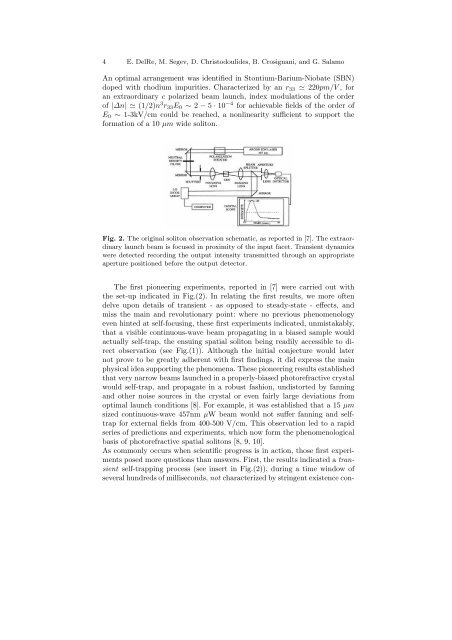Photorefractive Solitons (Chapter in Springer book ... - Tripod
Photorefractive Solitons (Chapter in Springer book ... - Tripod
Photorefractive Solitons (Chapter in Springer book ... - Tripod
Create successful ePaper yourself
Turn your PDF publications into a flip-book with our unique Google optimized e-Paper software.
4 E. DelRe, M. Segev, D. Christodoulides, B. Crosignani, and G. Salamo<br />
An optimal arrangement was identified <strong>in</strong> Stontium-Barium-Niobate (SBN)<br />
doped with rhodium impurities. Characterized by an r33 220pm/V ,for<br />
an extraord<strong>in</strong>ary c polarized beam launch, <strong>in</strong>dex modulations of the order<br />
of |∆n| (1/2)n 3 r33E0 ∼ 2 − 5 · 10 −4 for achievable fields of the order of<br />
E0 ∼ 1-3kV/cm could be reached, a nonl<strong>in</strong>earity sufficient to support the<br />
formation of a 10 µm wide soliton.<br />
Fig. 2. The orig<strong>in</strong>al soliton observation schematic, as reported <strong>in</strong> [7]. The extraord<strong>in</strong>ary<br />
launch beam is focused <strong>in</strong> proximity of the <strong>in</strong>put facet. Transient dynamics<br />
were detected record<strong>in</strong>g the output <strong>in</strong>tensity transmitted through an appropriate<br />
aperture positioned before the output detector.<br />
The first pioneer<strong>in</strong>g experiments, reported <strong>in</strong> [7] were carried out with<br />
the set-up <strong>in</strong>dicated <strong>in</strong> Fig.(2). In relat<strong>in</strong>g the first results, we more often<br />
delve upon details of transient - as opposed to steady-state - effects, and<br />
miss the ma<strong>in</strong> and revolutionary po<strong>in</strong>t: where no previous phenomenology<br />
even h<strong>in</strong>ted at self-focus<strong>in</strong>g, these first experiments <strong>in</strong>dicated, unmistakably,<br />
that a visible cont<strong>in</strong>uous-wave beam propagat<strong>in</strong>g <strong>in</strong> a biased sample would<br />
actually self-trap, the ensu<strong>in</strong>g spatial soliton be<strong>in</strong>g readily accessible to direct<br />
observation (see Fig.(1)). Although the <strong>in</strong>itial conjecture would later<br />
not prove to be greatly adherent with first f<strong>in</strong>d<strong>in</strong>gs, it did express the ma<strong>in</strong><br />
physical idea support<strong>in</strong>g the phenomena. These pioneer<strong>in</strong>g results established<br />
that very narrow beams launched <strong>in</strong> a properly-biased photorefractive crystal<br />
would self-trap, and propagate <strong>in</strong> a robust fashion, undistorted by fann<strong>in</strong>g<br />
and other noise sources <strong>in</strong> the crystal or even fairly large deviations from<br />
optimal launch conditions [8]. For example, it was established that a 15 µm<br />
sized cont<strong>in</strong>uous-wave 457nm µW beam would not suffer fann<strong>in</strong>g and selftrap<br />
for external fields from 400-500 V/cm. This observation led to a rapid<br />
series of predictions and experiments, which now form the phenomenological<br />
basis of photorefractive spatial solitons [8, 9, 10].<br />
As commonly occurs when scientific progress is <strong>in</strong> action, those first experiments<br />
posed more questions than answers. First, the results <strong>in</strong>dicated a transient<br />
self-trapp<strong>in</strong>g process (see <strong>in</strong>sert <strong>in</strong> Fig.(2)), dur<strong>in</strong>g a time w<strong>in</strong>dow of<br />
several hundreds of milliseconds, not characterized by str<strong>in</strong>gent existence con-


